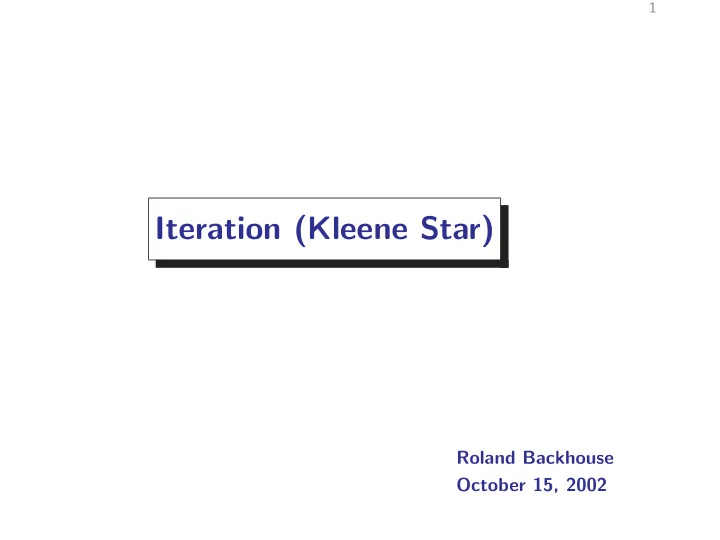

1 Iteration (Kleene Star) Roland Backhouse October 15, 2002
2 Outline • Axioms • Calculational Properties • Graphs and Matrices
3 Iteration (“Kleene star”) a ∗ · b is a prefix point of the function mapping x to b + a · x : b + a · ( a ∗ · b ) ≤ a ∗ · b , and is the least among all such prefix points: a ∗ · b ≤ x b + a · x ≤ x . ⇐ b · a ∗ is a prefix point of the function mapping x to b + x · a : b +( b · a ∗ ) · a ≤ b · a ∗ , (1) and is the least among all such prefix points: b · a ∗ ≤ x ⇐ b + x · a ≤ x . (2)
4 Interpretations Languages a , b , c , . . . x , y and z are sets of words. a ∗ is the set of all words formed by repeated concatenation of words in the language a . Relations a , b , c , . . . x , y and z are binary relations on some set A . (That is, a set of pairs of elements of A .) a ∗ is the reflexive, transitive closure of a . That is, a ∗ is the smallest relation that contains a and is reflexive and transitive. (Thus a ∗ is the smallest preorder containing a .) Booleans (The interpretation of + is disjunction, the interpretation of · is conjunction.) a ∗ is true for all booleans a . Costs (The interpretation of + is minimum, the interpretation of · is (real) addition.) a ∗ is 0 for all nonnegative a . a ∗ is − ∞ for negative a .
5 Extremal Path Problems ✗✔ ✗✔ 3 ✲ a b ✖✕ ✖✕ ❅ ✻ ❅ ❅ 5 2 ❅ 4 ❅ ❅ ✗✔ ✗✔ ❄ ❘ ❅ 2 ✛ ✲ d c ✖✕ ✖✕ 8 Edge labels are used to “weight” paths, and the problem is to find the “extreme” weight of paths between given pairs of nodes.
6 Interpretations — Matrices Suppose A is a square matrix representing the edges in a labelled graph. Suppose the edge labels are elements of a Kleene algebra. A ∗ represents paths through the graph A of arbitrary (finite) edge length. The ( i,j )th element of A ∗ is the Kleene sum over all finite-length paths p from node i to node j of the weight of path p (the Kleene product of the path’s edge labels).
7 Interpretations • Boolean matrices. (Kleene addition is “or”, multiplication is “and”. Assume that the ( i,j )th element of A is true exactly when there is an edge in the graph represented by A from node i to node j . The ( i,j )th element of A ∗ is true exactly when there is a path of arbitrary edge-length from node i to node j . • Cost matrices. (Kleene addition is “minimum”, Kleene multiplication is (real) addition.) Assume that the ( i,j )th element of A is the cost of the edge from node i to node j . The ( i,j )th element of A ∗ is the least cost of going from node i to node j . • Height matrices. (Kleene addition is “maximum”, Kleene multiplication is “minimum”.) Assume that the ( i,j )th element of A is the height of an underpass on the road from node i to node j . The ( i,j )th element of A ∗ is the height of the lowest underpass on the best route from node i to node j .
8 Properties reflexivity 1 ≤ a ∗ , transitivity a ∗ = a ∗ · a ∗ , closure operator a ≤ b ∗ ≡ a ∗ ≤ b ∗ .
9 Further Properties leapfrog a · b ∗ ≤ c ∗ · a ⇐ a · b ≤ c · a , c ∗ · a ≤ a · b ∗ ⇐ c · a ≤ a · b , a · b ∗ = c ∗ · a ⇐ a · b = c · a , mirror a · ( b · a ) ∗ = ( a · b ) ∗ · a , decomposition ( a + b ) ∗ = b ∗ · ( a · b ∗ ) ∗ = ( b ∗ · a ) ∗ · b ∗ , idempotency ( a ∗ ) ∗ = a ∗ . Exercise: Prove the properties not proved in the lectures.
Recommend
More recommend